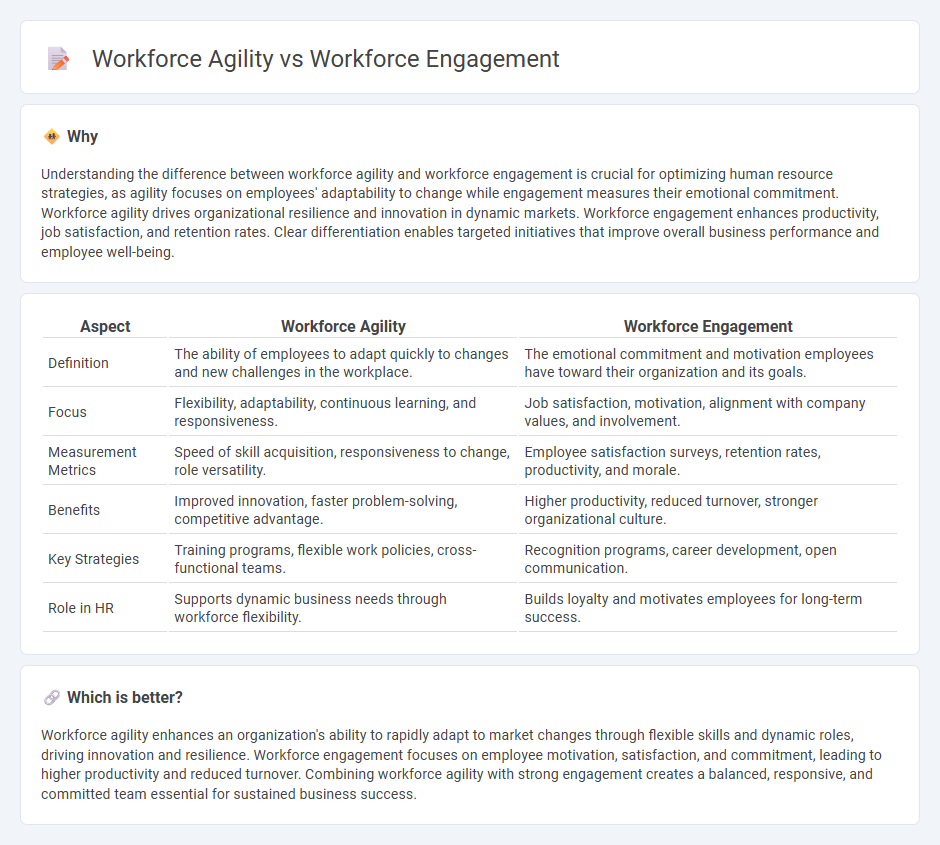
Workforce agility refers to an organization's ability to rapidly adapt its workforce to changing business environments through flexible skills and roles, while workforce engagement focuses on employees' emotional commitment and motivation towards their work and company goals. High workforce agility enables businesses to respond promptly to market shifts, and strong workforce engagement leads to increased productivity and reduced turnover. Explore how balancing these critical human resources strategies can drive sustained organizational success.
Why it is important
Understanding the difference between workforce agility and workforce engagement is crucial for optimizing human resource strategies, as agility focuses on employees' adaptability to change while engagement measures their emotional commitment. Workforce agility drives organizational resilience and innovation in dynamic markets. Workforce engagement enhances productivity, job satisfaction, and retention rates. Clear differentiation enables targeted initiatives that improve overall business performance and employee well-being.
Comparison Table
| Aspect | Workforce Agility | Workforce Engagement |
|---|---|---|
| Definition | The ability of employees to adapt quickly to changes and new challenges in the workplace. | The emotional commitment and motivation employees have toward their organization and its goals. |
| Focus | Flexibility, adaptability, continuous learning, and responsiveness. | Job satisfaction, motivation, alignment with company values, and involvement. |
| Measurement Metrics | Speed of skill acquisition, responsiveness to change, role versatility. | Employee satisfaction surveys, retention rates, productivity, and morale. |
| Benefits | Improved innovation, faster problem-solving, competitive advantage. | Higher productivity, reduced turnover, stronger organizational culture. |
| Key Strategies | Training programs, flexible work policies, cross-functional teams. | Recognition programs, career development, open communication. |
| Role in HR | Supports dynamic business needs through workforce flexibility. | Builds loyalty and motivates employees for long-term success. |
Which is better?
Workforce agility enhances an organization's ability to rapidly adapt to market changes through flexible skills and dynamic roles, driving innovation and resilience. Workforce engagement focuses on employee motivation, satisfaction, and commitment, leading to higher productivity and reduced turnover. Combining workforce agility with strong engagement creates a balanced, responsive, and committed team essential for sustained business success.
Connection
Workforce agility directly enhances workforce engagement by fostering a culture of adaptability and continuous learning that motivates employees to stay committed and productive. Agile teams respond swiftly to changes, which boosts job satisfaction and reduces turnover rates, creating a resilient and engaged workforce. High engagement levels, in turn, enable organizations to maintain operational agility by encouraging proactive problem-solving and collaboration across all departments.
Key Terms
Employee Motivation
Workforce engagement drives employee motivation by fostering commitment, satisfaction, and a sense of purpose, which directly impacts productivity and retention. Workforce agility emphasizes adaptability and quick response to change, requiring motivated employees to embrace continuous learning and innovation. Explore how integrating workforce engagement strategies enhances motivation and boosts organizational agility.
Change Adaptability
Workforce engagement drives employee motivation and commitment, crucial for maintaining productivity during organizational changes. Workforce agility emphasizes the ability to quickly adapt to change by developing flexible skills and a growth mindset, enhancing overall change adaptability. Explore how optimizing both engagement and agility can empower your team to thrive in dynamic business environments.
Productivity
Workforce engagement drives productivity by fostering employee motivation, commitment, and satisfaction, leading to higher performance and reduced turnover. Workforce agility enhances productivity through adaptability, quick decision-making, and continuous skill development in response to changing market demands. Explore how combining engagement and agility strategies can maximize your organization's productivity.
Source and External Links
What is Workforce Engagement? | NiCE - Workforce engagement is the level of commitment, enthusiasm, and dedication employees have toward their work and organization, fostered by communication, growth opportunities, and recognition strategies.
What is Employee Engagement? (And How to Boost It) - Employee engagement boosts productivity, retention, customer satisfaction, lowers absenteeism, improves health and safety, and strengthens trust in leadership and employer brand.
How to Improve Employee Engagement in the Workplace - Gallup.com - Engaged employees deliver higher productivity, profitability, wellbeing, and customer loyalty while reducing absenteeism, turnover, safety incidents, and quality defects, making engagement vital for organizational success.
 dowidth.com
dowidth.com